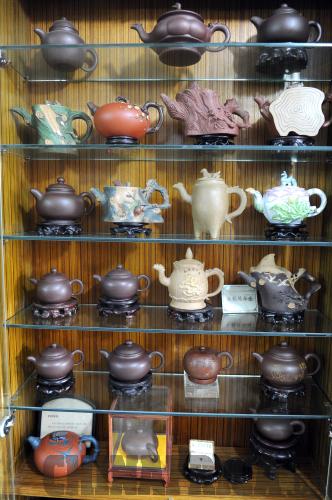| 
Teapots Made of Zisha
People worldwide drink Chinese tea daily and may be familiar with all kinds of East Asian teas. But dry leaves alone do not capture everything there is to know about China's tea culture. To become a qualified tea drinker, there is much to learn about the pots in which the leaves are brewed.
Prior to the Tang Dynasty (618-907), the Chinese drank tea with the same dishware they used at regular meals. As the beverage increased in popularity, a tea service was created and then improved upon. By the end of the Tang Dynasty, the zisha teapot had emerged.
The function of the zisha teapot in Chinese tea ceremonies is as important today as it was 400 years ago. This very elegant but simple style of earthenware seems to have informed the trajectory of tea consumption in China; over the centuries, tea preparation evolved from a complex practice to something less baroque. Today, the term zisha is synonymous with the art of tea.
Tea connoisseurs are sensitive to subtle differences in flavor and aroma emitted from the boiled leaves. In the pursuit of delicate tastes and texture, zisha teapots are indispensable.
One of the secrets of zisha pottery lies in its material. "Zisha" translates from Chinese as "purple sand clay." This clay features distinctive mineral content: the iron contained within sustains the high temperature of heated water, which enriches tea infusions. The delicate oils in tealeaves are also absorbed into the walls of the pot to accentuate the quality and characteristics of subsequent brews.
Zisha pottery is also known as yixing zisha. Yixing, located in southern part of Jiangsu Province, is the clay's point of origin, so to speak. Zisha teapots were first constructed in the mountainous area, where the 350-million-year-old mineral deposits rest.
After unprocessed zisha is mined and extracted, the clay is laid out and weathered naturally by the sun, wind and rain. Higher quality clay is weathered for several years before being processed. The material must repeatedly go through time-consuming processes before the mature clay can eventually be molded into various pieces of pottery.
The worked zisha clay possesses many unique characteristics. Its good plasticity helps the raw clay to maintain a nice balance between flexibility and firmness, and it can be easily fashioned into many different sizes and shapes coupled with sharp, distinct designs. The clay's cohesiveness is also strong but not sticky when molded, regardless if this is done by hand or with tools. This is especially important since zisha teapots are rolled and pressed, not thrown like some other forms of ceramic wares.
Zisha clay's shrinking force is very small. It only reduces in size about 10 percent from molding to when it's fired in a kiln. This allows for precise fitting and closely matched lids, factors that help the teapots retain correct water temperatures for complete tea infusions.
Zisha pottery's other secret is its distinct double-pore surface. These microscopic holes not only allow the pot to adapt to drastic changes in temperature, they also allow tea brews to breathe. This interval brings out the fragrance, color and taste of the original tealeaves.
Modernization has mechanized these techniques, bringing zisha teapots into an age of mass production. Machine-made zisha pottery comes at a cheap price, but for the hand-made pieces it's a different matter all together. A high-quality zisha teapot must be made by a ceramics master and is costly for consumers. With its skilled and complex construction, the teapot is very popular among collectors. But unlike most respected art forms, the zisha teapot is not just for decoration. It is a tea brew's most important partner, and is to be used and enjoyed. |